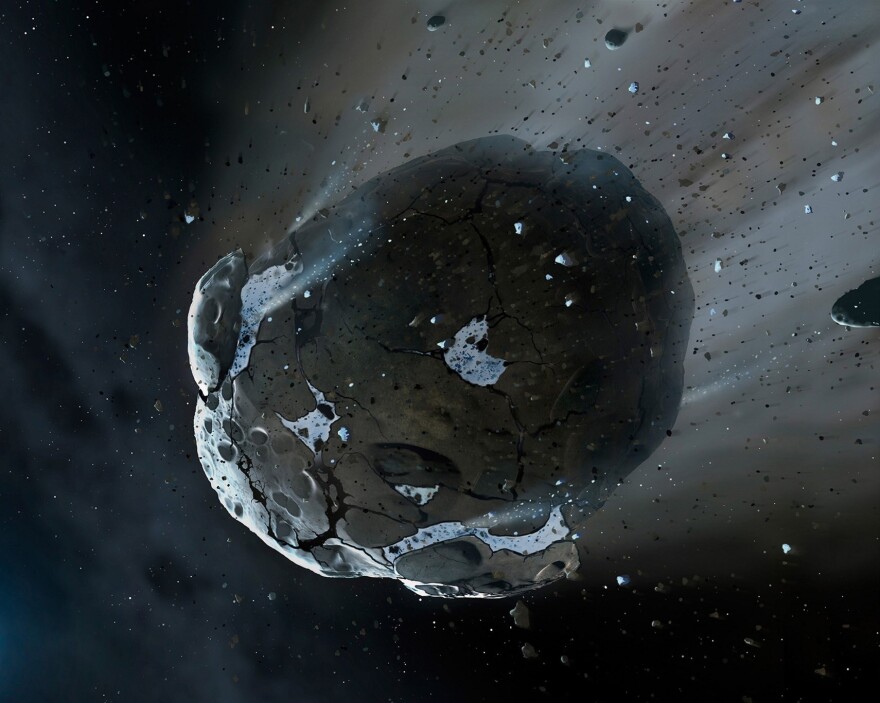Astronomers at Northern Arizona University are searching for a special kind of asteroid, and they want the public to help. “Active asteroids” are strange space rocks with tails, and they may hold clues about the origin of water on Earth. KNAU’s Melissa Sevigny spoke with project lead Colin Orion Chandler about how citizens around the world are speeding up the process of finding these rare objects.
Tell me what is an asteroid, and specifically what is an asteroid that is active?
An asteroid, the easiest way to think about it is a rock that’s floating in space, and usually when we say asteroid we’re talking about larger rocks…. But an active asteroid is one of these asteroids that’s orbiting that for some reason has developed comet-like features, such as a tail or what’s called a coma which is like the dust cloud that people think of; looks like a little halo. They’re kind of unusual because they’re not expected to be comets that are in the asteroid belt; if it’s just a rock why does it have a tail?
So you’re interested in studying active asteroids because they’re sort of behaving like comets and that means they’ve got to have something happening with water on them?
Yeah, it doesn’t necessarily have to be water, we’ve seen cases where they’ve had an impact from another asteroid for example and that releases a bunch of dust, and it’s short lived, etc. But yeah, I’m mostly interested for this idea of volatiles and understanding the origins of water…. Historically we don’t really know where the water on Earth came from. It’s believed some of it came with the place, during formation, and it’s also believed some was delivered after the fact. Comets are usually what are discussed in that context, but we now know that comets could not have delivered all the water that we find on the Earth today. So where did the rest of it come from?... If it turns out active asteroids have a good amount of water in them, that could actually help explain where a lot of the water on Earth came from.
How many active asteroids do we know about?
That’s the thing. They’re actually quite rare. We know of fewer than thirty… So these objects are pretty rare but they’re also pretty difficult to detect, in part because they’re faint, small, dark, and faraway.
So tell me about this citizen science project you’re launching.
Right, that’s where the citizen scientists come in. It’s a very simple process, we just have pictures of asteroids that we’ve put them in this picture right in the middle so you can see where the asteroid is, and we want to know whether or not you can see a tail with it. It’s a yes/no question… and you can find this by going to activeasteroids.net and clicking on the button that says ‘click here to get started.’ You can have any background, you can commit as much or as little time as you want, you don’t need special training, we provide a little tutorial that gives everything that’s necessary. That’s one of the great benefits of citizen science, you can have this big public outreach and engagement all over the world across all kinds of people. … So far we’ve have a big outpouring of interest. As a matter of fact, our first batch was finished in 20 hours, what we thought would probably take weeks.
How long do you think it would take you, if it was just you and your team looking at these pictures, how long would it take you?
Great question, because a lot of people would probably first ask can’t you just get a computer to do this? In all honesty, if we could, we would. But as it turns out, it’s quite difficult to do. These tails and activity come in all shapes and sizes, and there is every kind of phenomena and background galaxy you can think of.… If it was up to me to sit down and do it, it would take probably decades. In reality I’d probably never finish because more data continues to come in.
What most excites you about doing this project?
It’s really twofold, the science is really awesome and the outreach is really awesome. It’s been really awesome engaging with citizens all over the world that are contributing to this project, and seeing the excitement, and I can’t believe how fast we’ve made discoveries. People are coming from all walks of life. I really do enjoy being able to spread the joy of science that way.
Colin Chandler, thank you so much for speaking with me.
Thanks for having me.







